ANSYS 14.0 Automates Time-Intensive Operations, 2 in a Series
Automatically create meshes prior to setting up fluid dynamics simulations.
Latest News
January 25, 2012
By DE Editors
ANSYS Inc. (Canonsburg, PA) has launched ANSYS 14.0, the newest release of its engineering simulation technology suite. The new release, says the company, automates several user-intensive operations, allows more complex simulations, and delivers improved simulation speeds. New capabilities and enhancements can found across the range of tool sets that comprise ANSYS. Additionally, ANSYS 14.0 is said to feature a comprehensive suite of solver and HPC (high-performance computing) advancements across the entire range of physics.
ANSYS Workbench provides a framework for design exploration and optimization by enabling parametric modeling of geometric configurations, mesh controls, material properties, and operating conditions, leading to an automated simulation process. ANSYS 14.0 allows design point updates to be submitted for simultaneous execution via the remote solve manager (RSM), including cluster computing environments.
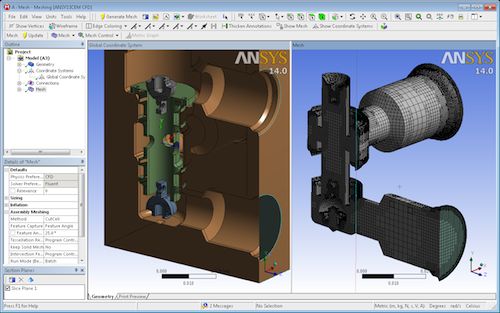
ANSYS Workbench Meshing automatically extracts and meshes the fluid
volume from complex CAD assemblies, according to the company. This example
shows a cut-cell hexahedral mesh, but the capability also allows users to create
tetrahedral meshes. For both approaches, inflation layers to resolve near-wall
flows are supported. Image courtesy of ANSYS, Inc.
For fluid dynamics analyses, ANSYS 14.0 automatically creates high-quality mesh prior to setting up a CFD (computational fluid dynamics) simulation. The assembly meshing tool extracts fluid volume from CAD assemblies automatically and creates structured Cartesian meshes or unstructured tetrahedral meshes automatically, depending on user goals and preferences.
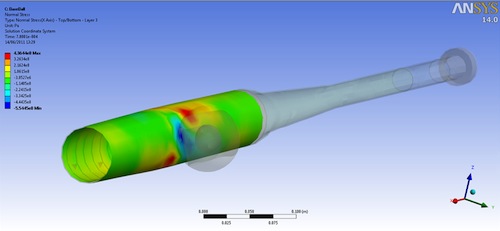
ANSYS Composite PrepPost is part of the project page and streamlines data
exchange with implicit or explicit solutions. This baseball bat example was
solved with an explicit simulation. Image courtesy of ANSYS Inc.
The dedicated ANSYS Composite PrepPost tool provides ease of use for composite structure models, and such challenges as the definition of hundreds or thousands of plies on a structure, including various orientations, or ply-by-ply analysis of the structure’s potential failure. ANSYS 14.0 is said to tightly integrate ANSYS Composite PrepPost with other simulations in ANSYS Workbench and provides specific modeling techniques for analysis of composites failure such as progressive failure. The automated algorithms for projecting data from one mesh to another as well as the weighting options are said to have been enhanced in ANSYS 14.0 to provide users with additional control and correction capabilities.
ANSYS 14.0 also introduces two-way electromagnetic coupling with stress analysis and the ability to re-simulate the electromagnetic field distribution on the deformed geometry. Applications include electrical machine, magnetic actuator, and electric transformer designs in the automotive, aerospace, and power industries for which accuracy of localized part deformations is important. Additionally, a new ANSYS Fluent co-simulation link with ANSYS Simplorer allows engineers to analyze battery systems in Simplorer without neglecting nonlinear behavior of the fluid system. The co-simulation, says ANSYS, delivers high-accuracy results of multi-domain system simulation using a fully integrated set of tools.
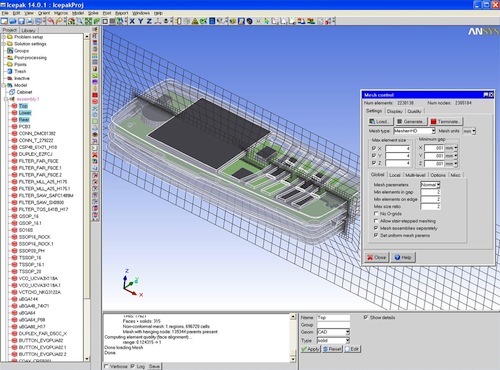
ANSYS has upgraded the graphical user interface for its ANSYS Icepak 14.0
CFD software for electronics thermal management. Image courtesy of ANSYS, Inc.
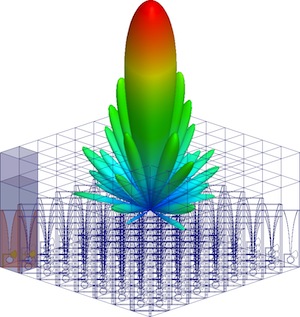 Far field antenna pattern of 8x8 antenna array solved with the new antenna array analysis capability in ANSYS 14.0. Image courtesy of ANSYS, Inc. |
ANSYS Icepak 14.0 CFD software for electronics thermal management, reports the company, has a new graphical user interface with new icons, redesigned menus and dialog boxes, expanded right-click functionality, enhanced graphics, and additional productivity enhancements. Improvements to ANSYS DesignModeler are said to enable engineers to simplify and create Icepak objects from mechanical CAD data rapidly. New variables in ANSYS CFD-Post (thermal chokepoint and thermal cross) are intended to allow engineers to identify areas with high thermal resistances and possible regions for a new heat flow path.
ANSYS 14.0 features a suite of solver and HPC advancements across the entire range of physics. Smart solver management enhancements, including architecture-aware partitioning, are said to evenly size and efficiently distribute jobs to available compute processors. With ANSYS Mechanical 14.0, users can take advantage of the latest generation of GPU boards as well as minimize the amount of I/O required for post-processing operations.
Other enhancements include a new finite array capability in ANSYS HFSS 14.0. The capability, built upon ANSYS’s domain decomposition and adaptive meshing technologies, models finite-sized antenna arrays explicitly. This “ time- and memory-efficient HPC technique properly predicts the array’s behavior including finite-size edge effects,” according to the company. Also new are advanced transient blade row methods in ANSYS CFX 14.0 CFD software for process and product design optimization, which the company says can dramatically reduce computation requirements, in terms of time and memory, for simulations of compressors or turbines.
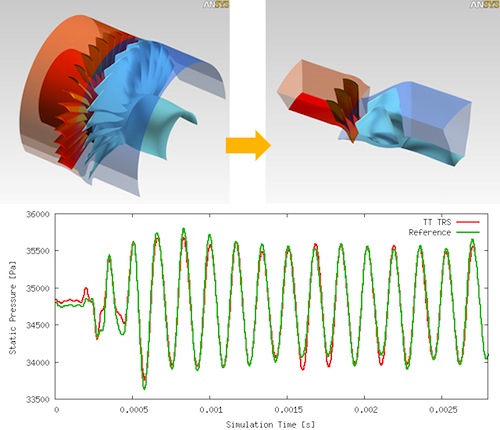
ANSYS explains that the new transient blade row models in ANSYS CFX 14.0
simulate only two to three blade passages without any loss in accuracy. The
graph is a comparison of the results between a full-scale system and a
reduced system in which the transient blade row model is used. Image
courtesy of ANSYS, Inc.
ANSYS version 14.0 is available now. For more information on ANSYS 14.0, visit ANSYS.
Go here for ANSYS 14 release highlights.
Download a PDF on the capabilities of ANSYS 14.0.
Visit the ANSYS Resource Library.
See why DE’s editors selected ANSYS 14.0 as their Pick of the Week.
Sources: Press materials received from the company and additional information gleaned from the company’s website.
Subscribe to our FREE magazine, FREE email newsletters or both!
Latest News
About the Author
DE’s editors contribute news and new product announcements to Digital Engineering.
Press releases may be sent to them via [email protected].






